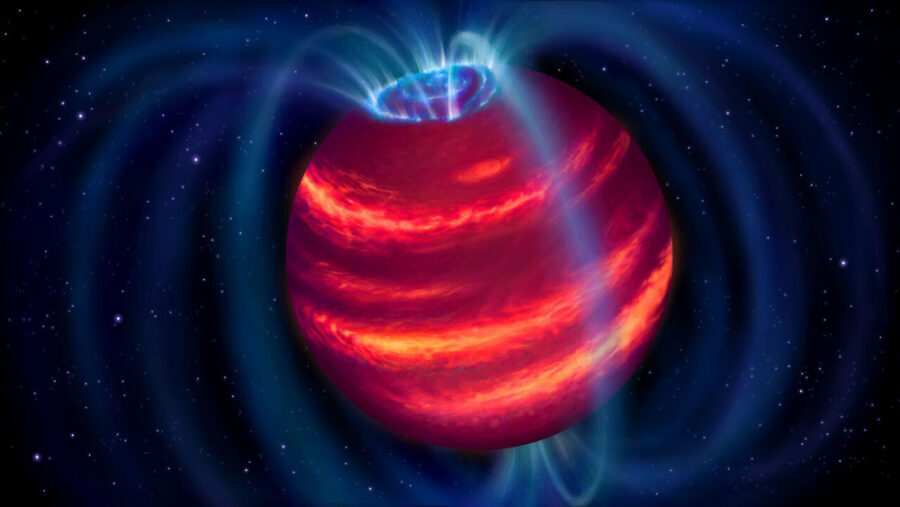The radio discovery of a brown dwarf holds promise for future exoplanet detections.

ASTRON / Danielle Futselaar
For the first time ever, astronomers have found a cool brown dwarf with a radio telescope. The discovery suggests that future radio surveys may even turn up radio-emitting exoplanets that are too cool to detect by any other means. “It’s a very exciting result,” says David Charbonneau (Center for Astrophysics, Harvard & Smithsonian).
Electrons spiraling in the brown dwarf’s magnetic field produce the radio emission we see. According to study lead Harish Vedantham (ASTRON Netherlands Institute for Radio Astronomy), the radio waves are a low-energy form of synchrotron radiation. “Most likely, the same electrons also produce aurorae in the dwarf star’s atmosphere,” he says.
Radio-emitting brown dwarfs aren’t surprising by themselves: Radio waves from a known brown dwarf were first detected in 2001. And in 2012, Matthew Route and Aleksander Wolszczan (both at Penn State) detected radio emission from a cool “methane dwarf,” which has a surface temperature of just 900 degrees above absolute zero. However, that dwarf had first been found by its infrared glow in the Two Micron All-Sky Survey (2MASS), so the astronomers knew where to point their radio dish.
But until now, astronomers have never detected brown dwarfs solely by their radio emission. Now, the Low-Frequency Array (LOFAR) Two-metre Sky Survey has detected the new object, dubbed BDR 1750+380, in the constellation Hercules, based only on its strongly polarized radio waves.
LOFAR is an international network of more than 100,000 simple antennas, with its core in The Netherlands. Because of the low frequencies it detects, the array is sensitive to emissions from brown dwarfs, and maybe even planets with relatively small magnetic fields.
Vedantham and his colleagues used the Gemini North telescope and NASA’s Infrared Telescope Facility, both on Mauna Kea, Hawai‘i, to confirm that their radio source is a bona fide methane dwarf with spectral type T6.5 at a distance of just over 200 light-years. Its magnetic field is at least 25 Gauss strong, comparable to planetary-scale magnetic fields. The discovery appears in the November 10th Astrophysical Journal Letters.
“It’s essential that the existence of the brown dwarf has been confirmed by infrared observations,” comments Charbonneau. “A radio signal alone would certainly not be enough.” Wolszczan agrees. “Radio detection tells you nothing about the spectral type of the object, although you get its magnetic field, and, possibly its rotation period, if the detected emission is periodic,” he says.
The authors believe there’s more in store. “With LOFAR, we want to go down the mass ladder all the way to Jupiter-like planets that are too faint to have been found in existing infrared surveys,” says co-discoverer Joe Callingham (Leiden Observatory). He has bestowed the brown dwarf with the name Elegast, after a dwarf-like spirit in a 12th-century Middle Dutch poem.
“I’m particularly excited whenever a new method is developed to study exoplanets, since each method offers unique information,” Charbonneau says. “I’ll be following this project closely to see if this detection is followed by others.”
 0
0









Comments
You must be logged in to post a comment.